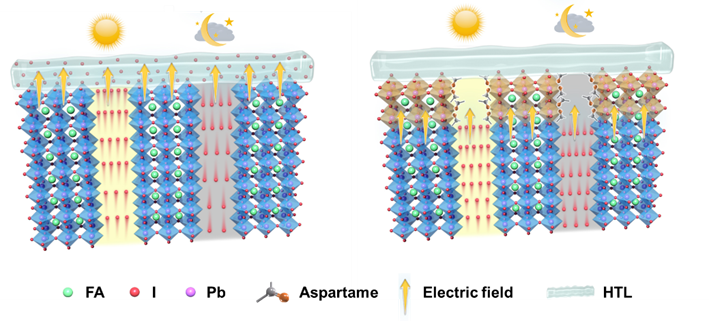Recently, the research group from Shanghai Jiao Tong University, cooperated with the scientist from University of California Los Angeles, made important progress in enhancing the stability of high-efficient perovskite solar cells. Relevant results have been published in Nature Photonics, entitled “Efficient and stable perovskite solar cells with regulated depletion region” (DOI: 10.1038/s41566-024-01383-5). Associate professor Qifeng Han, professor Yang Yang and professor Liyuan Han are the corresponding authors. PHD student Zhichao Shen in 2018 entry is the first author. Shanghai Jiao Tong University is the first completement affiliation.
The research team firstly proposed the strategy of moving the depletion region from the surface of perovskite film into the interior, therefore fundamentally suppressing the irreversible ion migration, which protect the perovskite layer and transport layer from destruction during the operation. The resulted perovskite solar cells loss less than 2% of the initial power conversion efficiency after operating for 10000 hours in the simulated operational condition, which opened up a new way to improve the stability of perovskite solar cells for the eventual commercialization.
The efficiency of single-junction perovskite solar cells has been over 26%, but the drawback in operational stability has hindered its commercialization at present. One of the problems that caused efficiency loss is the ion migration in perovskite film during the operation, as the structure of perovskite lattice and electrical property of transport layer and electrode would be changed when the ions migrated from perovskite layer into functional layer. Nowadays, interface engineering is the most popular strategy for suppressing ion migration which includes defects passivation and introducing a buffer layer. However, these ideas can not solve this problem fundamentally, as ions can inevitably migrate into transport layer for the presence of high ions concentration gradient and migration channels in the surface which owns high density of defects. The migrated ions can diffuse into the transport layer and electrode which lead to irreversible damage in the perovskite solar cells.
In this work, the research team regulated defects and changed the PN type in perovskite film by introducing a dopant. According to Darcy equation, the depth of depletion region is controllable by changing the ratio of density and viscosity of the dopant solvent. And therefore, the perovskite film can obtain a P-type region at the surface, while the interior is still the N-type. The strategy can create a built-in electric field in perovskite solar cell, which fundamentally suppressed the irreversible ion migration into interface, transport layer and electrode. The stability of resulted perovskite solar cells was significantly improved. The devices maintained over 88% of the initial efficiency after 1,920 h of continuous illumination under maximum power point conditions (65 °C in ambient air, following the ISOS-L-2 protocol). The power conversion efficiency returned to more than 94% of its initial value after overnight recovery. When operating under repeated 12 h light on/off cycles for over 10,000 h (solar simulator at 65 °C and ambient air, following the ISOS-LC-2 protocol), the efficiency loss is less than 2%. This method opened up new and effective avenues towards enhancing the long-term stability of high-performance perovskite photovoltaics, and promoted the commercialization process.

Figure 1. The left is the potential and electric field distribution in the solar cell before regulating the depletion region, the right is the potential and field distribution in the solar cell after regulating depletion region.

Figure 2. The left the electric field distribution and ion migration in the solar cell before regulating the depletion region, the right is the electric field distribution and ion migration in the solar cell after regulating the depletion region.
